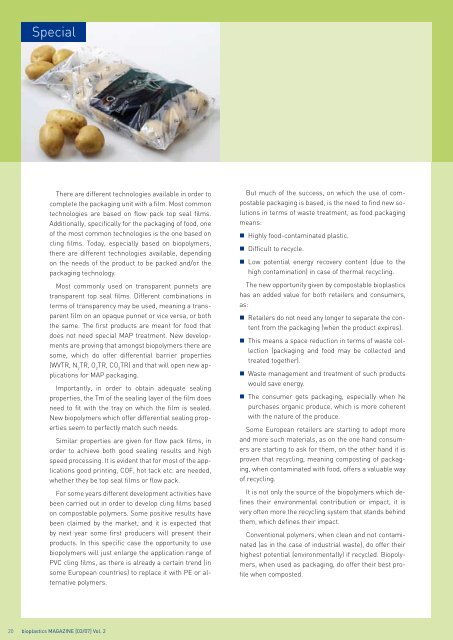bioplasticsMAGAZINE_0703
bioplasticsMAGAZINE_0703
bioplasticsMAGAZINE_0703
Create successful ePaper yourself
Turn your PDF publications into a flip-book with our unique Google optimized e-Paper software.
Special<br />
There are different technologies available in order to<br />
complete the packaging unit with a film. Most common<br />
technologies are based on flow pack top seal films.<br />
Additionally, specifically for the packaging of food, one<br />
of the most common technologies is the one based on<br />
cling films. Today, especially based on biopolymers,<br />
there are different technologies available, depending<br />
on the needs of the product to be packed and/or the<br />
packaging technology.<br />
Most commonly used on transparent punnets are<br />
transparent top seal films. Different combinations in<br />
terms of transparency may be used, meaning a transparent<br />
film on an opaque punnet or vice versa, or both<br />
the same. The first products are meant for food that<br />
does not need special MAP treatment. New developments<br />
are proving that amongst biopolymers there are<br />
some, which do offer differential barrier properties<br />
(WVTR, N 2<br />
TR, O 2<br />
TR, CO 2<br />
TR) and that will open new applications<br />
for MAP packaging.<br />
Importantly, in order to obtain adequate sealing<br />
properties, the Tm of the sealing layer of the film does<br />
need to fit with the tray on which the film is sealed.<br />
New biopolymers which offer differential sealing properties<br />
seem to perfectly match such needs.<br />
Similar properties are given for flow pack films, in<br />
order to achieve both good sealing results and high<br />
speed processing. It is evident that for most of the applications<br />
good printing, COF, hot tack etc. are needed,<br />
whether they be top seal films or flow pack.<br />
For some years different development activities have<br />
been carried out in order to develop cling films based<br />
on compostable polymers. Some positive results have<br />
been claimed by the market, and it is expected that<br />
by next year some first producers will present their<br />
products. In this specific case the opportunity to use<br />
biopolymers will just enlarge the application range of<br />
PVC cling films, as there is already a certain trend (in<br />
some European countries) to replace it with PE or alternative<br />
polymers.<br />
But much of the success, on which the use of compostable<br />
packaging is based, is the need to find new solutions<br />
in terms of waste treatment, as food packaging<br />
means:<br />
• Highly food-contaminated plastic.<br />
• Difficult to recycle.<br />
• Low potential energy recovery content (due to the<br />
high contamination) in case of thermal recycling.<br />
The new opportunity given by compostable bioplastics<br />
has an added value for both retailers and consumers,<br />
as:<br />
• Retailers do not need any longer to separate the content<br />
from the packaging (when the product expires).<br />
• This means a space reduction in terms of waste collection<br />
(packaging and food may be collected and<br />
treated together).<br />
• Waste management and treatment of such products<br />
would save energy.<br />
• The consumer gets packaging, especially when he<br />
purchases organic produce, which is more coherent<br />
with the nature of the produce.<br />
Some European retailers are starting to adopt more<br />
and more such materials, as on the one hand consumers<br />
are starting to ask for them, on the other hand it is<br />
proven that recycling, meaning composting of packaging,<br />
when contaminated with food, offers a valuable way<br />
of recycling.<br />
It is not only the source of the biopolymers which defines<br />
their environmental contribution or impact, it is<br />
very often more the recycling system that stands behind<br />
them, which defines their impact.<br />
Conventional polymers, when clean and not contaminated<br />
(as in the case of industrial waste), do offer their<br />
highest potential (environmentally) if recycled. Biopolymers,<br />
when used as packaging, do offer their best profile<br />
when composted.<br />
20 bioplastics MAGAZINE [03/07] Vol. 2


















